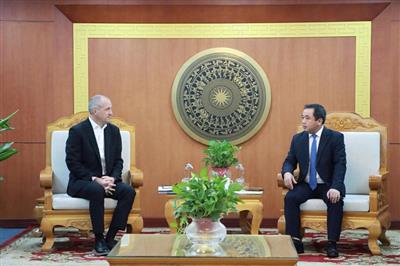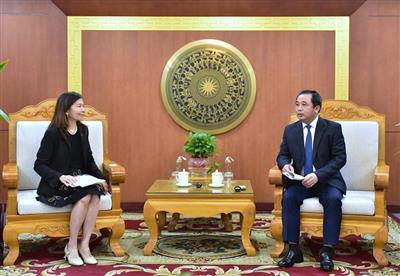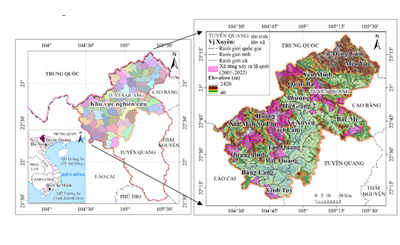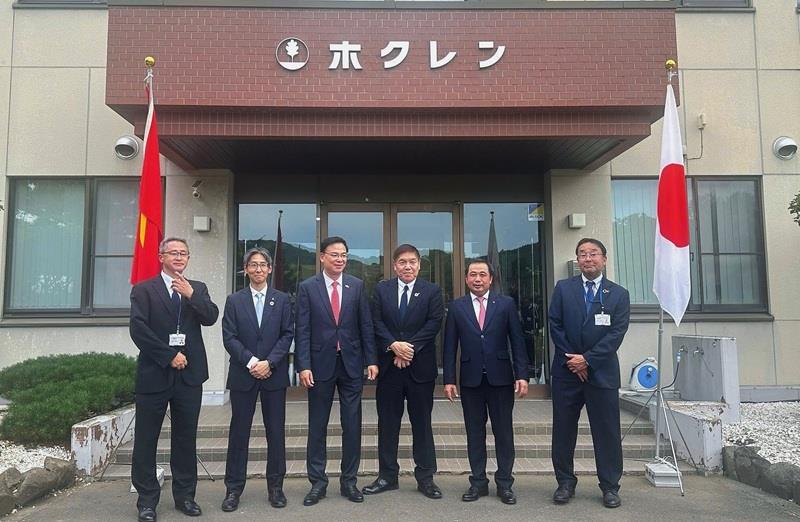
“Early warning must stay one step ahead of disasters”: Proactive solutions from the meteorology and hydrology sector
04/06/2025TN&MTIn the context of increasingly extreme and unpredictable climate change, natural disasters are not only occurring more frequently but are also accompanied by unprecedented risk combinations. Vietnam - one of the countries most severely affected - is facing an urgent need to comprehensively modernize its forecasting, warning, and disaster response systems. On the sidelines of the implementation conference for Resolution 57-NQ/TW in Bac Ninh in May 2025, Assoc. Prof. Dr. Mai Van Khiem, Director of the National Center for Hydro-Meteorological Forecasting (NCHMF), shared an in-depth interview with our reporter about breakthroughs in artificial intelligence applications, high-resolution forecasting models, and the vision to build a comprehensive early warning ecosystem that delivers “the right information to the right people at the right time in the right way.”
Q: Assoc. Prof. Dr. Mai Van Khiem, given the increasingly complex and severe climate change context, how do you assess the role of early warning in Vietnam’s disaster response strategy?
Assoc. Prof. Dr. Mai Van Khiem: Climate change is significantly increasing the intensity, frequency, and spatial extent of extreme weather events. In Vietnam, natural disasters are not only more frequent but also increasingly unpredictable and lacking clear patterns – for example, heavy rains occurring even during the dry season, abnormally strong storms, or complex risk combinations such as heavy rainfall accompanied by flash floods and landslides.
In this context, early warning becomes a key factor in mitigating disaster risks. An effective early warning system enables people and local authorities to proactively implement preventive and response measures. As we emphasized at the Bac Ninh conference, early warning must “stay one step ahead” – not only in terms of lead time but also in accuracy, specificity, and accessibility, making it easy for communities to understand and act on. This is why digital transformation and the application of science and technology in meteorology and hydrology have been identified as one of the critical breakthroughs in implementing Resolution 57-NQ/TW.
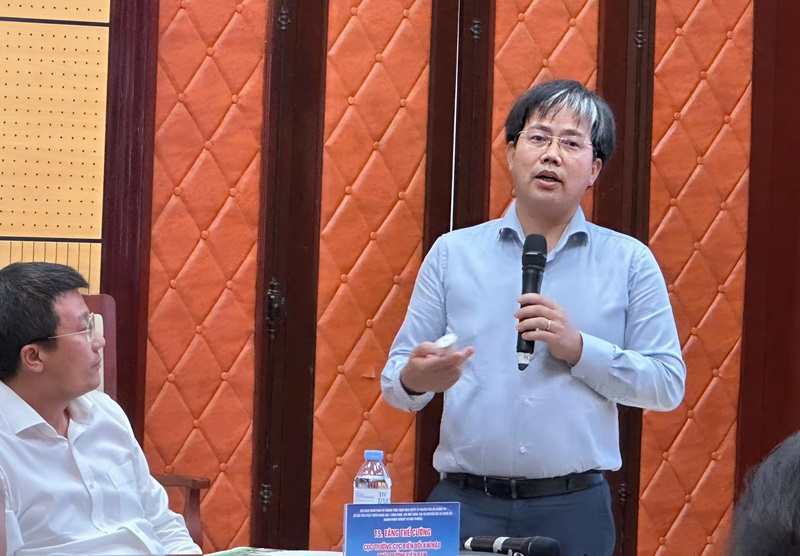
Assoc. Prof. Dr. Mai Van Khiem, Director of the National Centre for Hydro-Meteorological Forecasting, spoke at the Conference on the Implementation of Resolution No. 57-NQ/TW held in Bac Ninh in May 2025
Q: In your report at the conference, you mentioned many new technological solutions. Could you share more details about the technological advances in meteorological and hydrological forecasting achieved by your sector?
Assoc. Prof. Dr. Mai Van Khiem: Facing increasingly complex disasters and climate change, forecasting requirements are no longer just about “having information” but about “information being accurate, timely, and actionable.” With this mindset, over recent years, our sector has focused on innovating forecasting systems—from technological infrastructure and data sources to modeling operations and information dissemination.
A significant advance has been achieved through the deployment of the high-resolution numerical weather prediction model WRF-ARW, which is operated on a state-of-the-art CRAY supercomputer. Detailed simulation of atmospheric conditions across the entire territory of Vietnam at a spatial resolution of 3km × 3km is enabled by the system’s superior computational capacity, approaching the standards of advanced forecasting centers worldwide. Beyond simulation, multi-source data assimilation techniques—including surface and upper-air observation stations, domestic weather radar networks, and international satellite data—are integrated into the system to enhance forecast accuracy and real-time update capability.
Alongside traditional physical models, the application of artificial intelligence (AI) in very short-term forecasting (nowcasting) is being accelerated by the meteorology and hydrology sector (MHS. One concrete example is building a very short-term rainfall forecasting system using multi-source data that combines satellites, radars, and an automated rain gauge network. Leveraging machine learning and real-time image processing technologies, rainfall maps at 1km × 1km resolution, updated hourly, can be generated.. This forms the foundation for issuing thunderstorm, landslide, and flash flood warnings at the commune level, with lead times from one to six hours before the disaster occurs. Previously, such fine-scale forecasting was a major challenge, but it is gradually becoming a reality.
Notably, the pilot project AINPP—Artificial Intelligence for Nowcasting—under the World Meteorological Organization (WMO) initiative includes Vietnam’s MHS as one of its Asian participants. The project aims to apply AI to improve short-term hazardous weather forecasts and support developing countries in implementing “Early Warning for All” systems, a global initiative to reduce disaster risks at the community level.
Real-time monitoring systems for rainfall, floods, landslides, and reservoir operations are being developed in parallel with forecasting models, integrating field sensors with computational models and real-time data transmission systems. These systems have been piloted in major river basins such as the Red River, Da River, and Ma River, supporting decision-making in water management and emergency disaster response.
All these efforts aim to build a modern, proactive forecasting and warning platform capable of quickly adapting to climate change and better serving the protection of people, socio-economic development, and the environment.
Q: It is clear that the meteorology and hydrology sector is undergoing strong technological transformation. However, communicating information to communities—especially in remote and mountainous areas—remains a challenge. What solutions does the Center have for this?
Assoc. Prof. Dr. Mai Van Khiem: Exactly. No matter how accurate a warning message is, it cannot be effective if it does not reach people timely and in an understandable manner. Therefore, one of the four main pillars of implementing Resolution 57-NQ/TW in the MHS field is “risk communication and public awareness”
A multi-platform warning model combining mobile applications, web platforms, SMS, social networks, television, and local public address systems is being developed. At the same time, we emphasize location-based warnings—delivering detailed information down to localities and residential clusters, using simple, easy-to-understand, and accessible language. For example, a resident in Meo Vac district (Ha Giang) will receive warnings of heavy rainfall and flash flood risks on their phone or through the commune loudspeakers without needing to read lengthy technical bulletins.
Of course, achieving this requires inter-sectoral coordination—between meteorology, disaster prevention, transportation, agriculture, and education—to ensure information integration, correct usage, and maximum effectivenes
Q: What are the biggest challenges today in modernizing early warning systems?
Assoc. Prof. Dr. Mai Van Khiem: The biggest issue is the lack of synchronization in monitoring networks and data processing. Many areas, especially in the northern midlands and mountainous regions, still lack automatic rain gauges or soil moisture monitoring devices—while these are the areas most prone to flash floods and landslides. Data across systems have not yet been made interoperable and lack open data standards, which complicates analysis and information sharing.
Moreover, the high-tech workforce—especially experts in AI, modeling, and big data analytics—is limited and insufficient to meet the demands of the Fourth Industrial Revolution. Funding for research and technology trials remains low; there is a lack of incentives, socialization mechanisms, and connections with scientific organizations and technology enterprises both domestically and internationally.

Assoc. Prof. Dr. Mai Van Khiem hoped that, with a modern and comprehensive approach, the meteorology and hydrology sector would become the backbone of the national early warning system and contribute significantly to sustainable development amid increasing climate uncertainty
Q: Could you share the major directions of the meteorology and hydrology sector for 2025–2030 to enhance early warning capacity and climate change adaptation?
Assoc. Prof. Dr. Mai Van Khiem: During 2025–2030, to enhance early warning capacity and effectively adapt to climate change, four strategic pillars have been clearly defined by the Meteorology and Hydrology sector, with innovation and digital transformation as the foundational drivers.
First, researching and mastering core technologies in meteorological and hydrological forecasting. The development of integrated weather and climate forecasting models incorporating artificial intelligence (AI) and machine learning is being prioritized. This is the inevitable trend among modern forecasting centers worldwide to improve forecasting capabilities for hazardous weather phenomena such as storms, heavy rainfall, flash floods, droughts, and saltwater intrusion. Research on site-specific monitoring instruments for landslide warnings is also prioritized—such as rainfall sensors, water level gauges, soil moisture sensors, wire sensors, surveillance cameras, and acoustic devices—to integrate into an automatic warning system.
Second, developing a real-time integrated observation network. This is the prerequisite for transitioning from qualitative forecasting to quantitative, real-time warnings. Our approach is to build an automatic monitoring system integrating multiple advanced sensors (radar, remote sensing, UAVs, IoT) based on Vietnamese technology and cooperating with major technology corporations like Viettel and VNPT. Connecting monitoring stations with central analytical systems in real time will improve data input accuracy and timeliness—key factors determining forecast quality.
Third, processing and analyzing big data, building a digital platform for the meteorology and hydrology sector. All observational and forecasting data are aimed to be digitized, forming a real-time meteorological information supply chain. This infrastructure not only supports forecasting but also serves as valuable data resources for sectors such as agriculture, transportation, construction, and urban planning. Additionally, building a national digital meteorological platform will facilitate inter-regional and inter-sectoral connectivity, promoting the application of meteorological data in policymaking and socio-economic management.
Fourth, comprehensively innovating communication systems and multi-platform warnings. A proactive, personalized, and user-friendly early warning system is being gradually developed. Warnings will be integrated across many media: SMS, mobile apps, social networks, television, and grassroots loudspeakers, ensuring information reaches the right people at the right time and in the right context. We also focus on location-based warnings so that people in each commune, village, or hamlet receive warnings appropriate to their living areas. Furthermore, warning information is designed to be easy to understand for all groups—including students, the elderly, and ethnic minorities.
Alongside these long-term directions, we have proposed that the Ministry of Agriculture and Environment urgently implement some key tasks during 2025–2027. Specifically, developing and operating a meteorological and hydrological forecasting and warning information system for communities via mobile apps and web platforms; establishing a community-based real-time early warning system for landslides and flash floods connected with local data; and building a real-time flood forecasting technology framework for the Red River basin—a region facing high pressure from climate change and rapid urbanization. This will lay the foundation for expanding to other major river basins and regions nationwide.
With a comprehensive vision and a modern approach, the meteorology and hydrology sector is expected to serve as the backbone of the national risk early warning system and to make a significant contribution to sustainable development in the face of increasing climate uncertainty.
Q: Thank you very much, Assoc. Prof. Dr. Mai Van Khiem, for sharing such detailed insights. Your vision and efforts surely contribute significantly to Vietnam’s disaster risk reduction and climate resilience.
Ngoc Huyen


